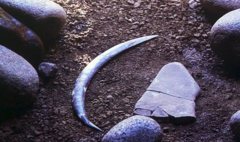Archaeological findings from Poland reveal a well-preserved mammoth ivory boomerang, challenging previous assumptions on its age and functional design, extending understanding of ancient tool-making.
Mystifying Discovery: The Oldest Boomerang Reveals Ancient Human Ingenuity

Mystifying Discovery: The Oldest Boomerang Reveals Ancient Human Ingenuity
Recent research suggests the world's oldest boomerang, believed to date back 40,000 years, sheds new light on prehistoric human innovation and usage.
Archaeologists have announced that the world's oldest known boomerang, unearthed in a Polish cave in 1985, is estimated to be approximately 40,000 years old, considerably older than the previously assumed age of 30,000 years. Discovered in Oblazowa Cave alongside animal and human bones, this artifact showcases the advanced skills of Homo sapiens during that era. Researchers utilized enhanced radiocarbon dating methods to ascertain the age based on associated bones, placing it between 39,000 and 42,000 years old.
Dr. Sahra Talamo from the University of Bologna emphasized the exceptional craftsmanship of the boomerang, which was carved from a mammoth’s tusk and designed for hunting, without the capability to return to the thrower. Its shape suggests proficient aerodynamics and indicates that ancient humans possessed a significant understanding of the tool's potential use, which may have extended beyond mere hunting to include cultural or artistic significance in rituals.
While boomerangs are commonly thought to belong to Aboriginal culture in Australia, this discovery indicates their use may have spanned various continents, supported by rare finds in Europe. For instance, the oldest known Australian boomerang, crafted from wood, is around 10,500 years old, and depictions of such tools appear in rock art that is about 20,000 years old.
Notably, additional historical artifacts have been found, including a wooden boomerang from Jutland, which dates back 7,000 years, and a two-millennia-old oak boomerang discovered in The Netherlands. The recent interdisciplinary research involving teams from Poland, Italy, Germany, France, Switzerland, and the UK was published in the journal PLOS One, significantly broadening the understanding of early human innovation and adaptability across different regions and cultures.




















